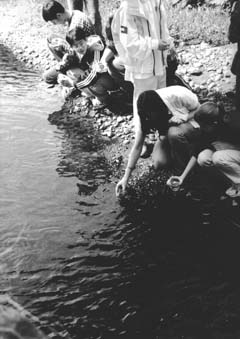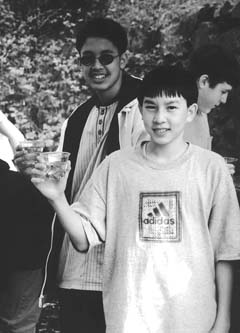
Surveys
DJC.COM
July 25, 2002
Linking up with the environment
GolfMarketingTeam.com

Photos courtesy of Glendale Country Bellevue School District students release juvenile fish into Kelsey Creek at Glendale. Club |
Stepping up to the challenge, the industry is implementing a multi-pronged effort with wide-reaching goals, ranging from promoting awareness of ways to protect and conserve natural resources to furthering understanding of golf’s relationship to the environment, both within and outside the golf community.
Industry officials say part of the impetus for an environmental focus came from news reports (many based on unsubstantiated or sensationalized claims) and opinion research that suggested golf courses had reckless disregard for the ecosystem. At times, some golf courses also reported workforce shortages, particularly among young adults who resisted associating with facilities they perceived to be bad environmental citizens.
The First Green
One component of the outreach effort began in 1992 with the American Society of Golf Course Architects (ASGCA). In collaboration with environmentalists, course superintendents, facility owners and other interest groups, ASGCA published “An Environmental Approach to Golf Course Development.” The detailed booklet, which has been updated and republished, provides a framework for creating a golf course that “lives harmoniously with the surrounding natural environment.”
|
Another endeavor, begun in Washington state in 1997, is a model for programs throughout the country. Now known as “The First Green,” the innovative educational outreach program uses golf courses as living laboratories to teach applied environmental science and other pertinent subject matter to high school students.
During the just-concluded school year, some 8,000 students statewide experienced at least some part of the widely endorsed curriculum. Topics range from environmental and agricultural principles used by golf courses to an overview of career opportunities at golf facilities.
Golf course superintendents, agriculture educators and the Future Farmers of America worked collaboratively to create the nonprofit First Green module, known initially as the High School Golf and Turfgrass Management Program.
In renaming the program, sponsors say they wanted a shorter and more memorable title and also hoped to extend some of the same attributes of the popular “First Tee” program, an initiative of the World Golf Foundation. Both concepts promote youth development through exposure to golf and its positive values.
Bill Meyer, chairman of the Washington State Golf Association Green Section and a volunteer with the turfgrass program since its inception, said First Green has multiple objectives. A primary goal is to teach applied environmental science using golf courses as outdoor labs.
Students meet turfgrass
At Sammamish High School in Bellevue, students commit to meeting two hours daily for the entire school year. Among topics covered are turfgrass biology, soil principles, irrigation and drainage, environmental science, pest management, golf course design, equipment maintenance and business management.
Working with Glendale Golf Club, the school’s nearby golf course partner, students can conduct research projects, pursue internships or gain summer employment.
Along with learning science in a fun and engaging way, students also acquire knowledge about various social, economic and recreational benefits that golf courses offer to communities. Through hands-on experiences, they gain understanding of myriad benefits golf courses provide, including preservation of green space, creation of wildlife habitats, restoration or reclamation of damaged areas like landfills and organic approaches to pest control.

Students participate in a fish restoration program at Glendale Country Club. |
Teachers are especially appreciative of the opportunity to use golf courses in fun and practical ways to teach science in a relevant, activity-based setting.
Referring to the “links as labs” feature of the program, volunteer Bill Meyer delights in reminding participants and potential donors that “Our outdoor laboratories come complete with the resources needed to teach agronomy, soils, environmental science, wildlife habitats, horticulture, aquaculture, pest management, water conservation and biology — not to mention equipment maintenance, architecture, customer service skills and business management.”
“This class gives us an opportunity to teach science principles in a very practical way,” said Randy Brown, teacher at Mount Vernon High School. “Students can apply the information to their own home lawns and landscaping,” he remarked. “Even if students do not have access to a greenhouse, they can experiment on portions of their own lawns.”
Brown also said he was “amazed” at how many students didn’t know what went on at a golf course when the year began. “It’s an eye-opener when they see the equipment used and the cost of maintenance at golf courses,” he said.
Teacher Steve Smith of Mount Tahoma High School in Tacoma lauded the golf course superintendents for their involvement with the program. “I have never seen an organization be so supportive of a school program,” he stated. “All the golf courses in my area have been very receptive and willing to help in any way they can.”
Smith also praised the endeavor for more practical reasons. “It is fun to be able to help students learn skills that I know can be put to immediate use to earn a good income.”
At Mount Tahoma, the living laboratory found at its partner golf courses will soon extend to the campus where a new school is being built. “I am helping with the design for the sports fields,” Smith said, noting students in the First Green program will eventually apply their newly acquired knowledge to help maintain the fields.
With 6,000 square feet earmarked for a putting green, Smith acknowledged it isn’t just the opportunity to test their science skills that appeals to students. “The golf portion of the class really is a draw for students. They like to get their hands on the clubs.”
Feedback from participants has been incredibly favorable, according to Meyer. He said students, mostly juniors and seniors, enjoy the variety of topics the course offers. They also say they like the chance to integrate agriculture, technology and ecology. Being able to apply classroom knowledge in meaningful, hands-on ways and exposure to various career opportunities also gets favorable marks from students.
Scholarships and grants
This year, for the first time, the superintendents embarked on special fund-raising activities so scholarships and grants could be added to the First Green program. Proceeds from a golf tournament and auction held in May at Spokane Country Club went to two primary beneficiaries — students and teachers.
The fund-raising efforts generated grant money for teachers to help defray costs for lab materials and field trips. A portion of the funds raised is earmarked for scholarships to help students who are interested in pursuing turfgrass management or other careers in the golf industry continue their education.
Since its inception in 1997 with around 20 urban high schools, the program now involves nearly 130 teachers and 5,000 students. Within five years, the superintendents hope to pair about 250 high schools statewide with a golf course in or near their community. That ambitious expansion could reach 25,000 students each year.
Supporters have outlined both short- and long-term goals to expand the program, promote its benefits and endow scholarships. A not-for-profit organization is being formed so the organization can accept donations in the form of grants, materials, in-kind services and scholarship contributions.
Meyer said curriculum materials are a major expense. Comprehensive kits valued at around $1,000 apiece are supplied to each instructor. The packet includes a textbook and curriculum guide, videotapes, posters depicting turf weeds, diseases and insects, calibration tools, slides, soil test kits, magnifying lenses and other instructional items.
Donations from various companies and organizations help defray about half the cost, according to Meyer. Among groups that have helped underwrite expenses for course materials are the Northwest Turfgrass Association, Western Washington and Inland Empire Golf Course Superintendents associations, The Toro Co., J.R. Simplot Co., Bean Meadows Co., R&R Products, Wilbur Ellis Co., Western Equipment and Walrath Trucking.
Meyer said financial and in-kind contributions from corporations, foundations and individuals are needed to support First Green’s expansion plans. Potential donors to the educational program are invited to contact Paul Backman at the Western Washington Golf Course Superintendents Association office in Olympia at (360) 705-3049; or John Saegner Jr. at the Washington State Golf Association in Seattle at (206) 526-8605.
Cheri Brennan, a public relations consultant, is part of GolfMarketingTeam.com and a volunteer for the First Green program.
Other Stories:
- Water storage goes underground
- No more fuming at chemistry class
- Getting back to basics with LEED
- Seattle LEEDs the nation in sustainable building
- New stormwater rules looming for contractors
- An incubator for cutting-edge power projects
- Designers find new life for old cardboard tubes
- EPA turns up the heat with temperature rules
- AGC teams with WSDOT for environment’s sake
- A wholistic look at engineering
- Toxic black mold — the next asbestos?
- Mold: Getting a grip on the fuzzy stuff
- A trail of mining waste turns into a trail of recreation
- A battery of energy information
- Managing stormwater in Pierce County
- New brownfields law comes with big changes
- ‘Green infrastructure’ puts Seattle on the map
- Detention ponds – all it takes is a little magic
- Ground zero for groundwater
- A pearl of a project on Oyster Creek
- BetterBricks program stacks up energy savings
- Shopping ‘green’
- Home Depot builds atop an old Oregon landfill
- Making clean water the green way
- Salmon in the city: Seattle restores fish habitat
- A funny thing happened on the way to the dump
- Reducing energy costs, post crisis
- Does best available science work for all buffers?
Copyright ©2009 Seattle Daily Journal and DJC.COM.
Comments? Questions? Contact us.